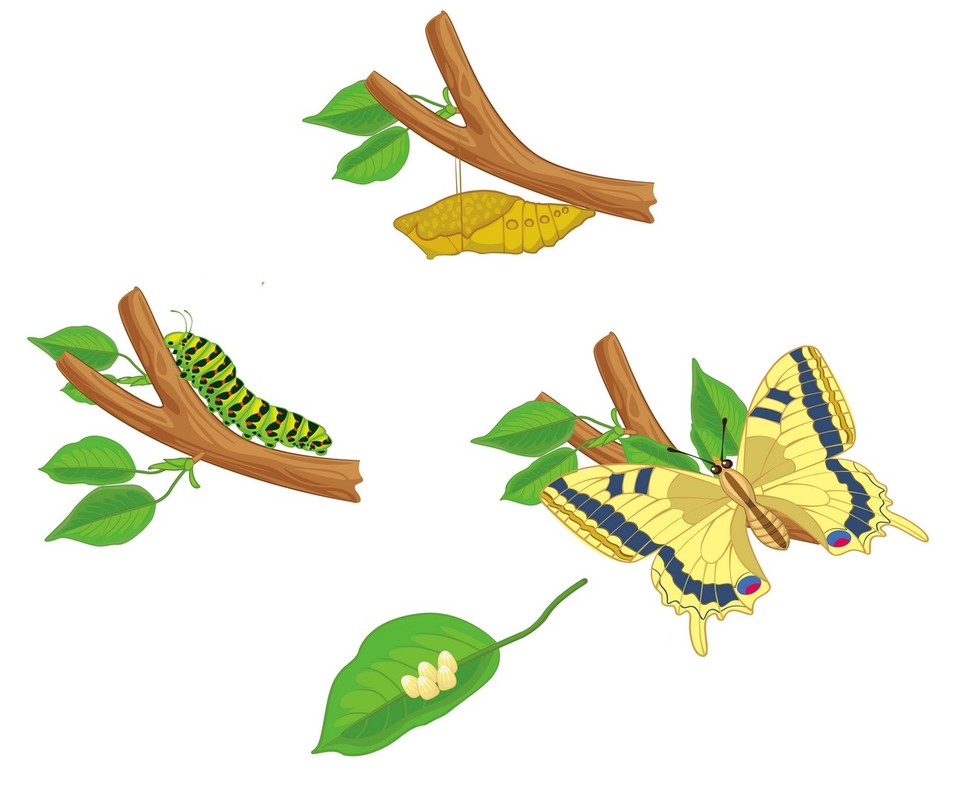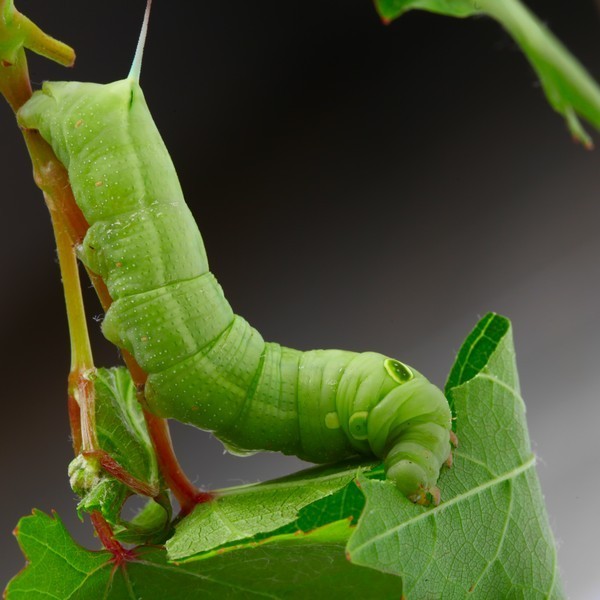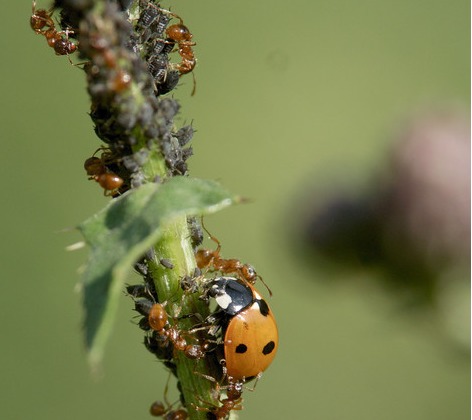5. Insects
Park insects

Shutterstock. Kuvan käyttö sallittu vain osana e-Oppi Oy:n oppimateriaalia.

© Oskari Härmä ja e-Oppi Oy

© Simo Veistola ja e-Oppi Oy

© Simo Veistola ja e-Oppi Oy

© Oskari Härmä ja e-Oppi Oy

© Simo Veistola ja e-Oppi Oy

Shutterstock. Kuvan käyttö sallittu vain osana e-Oppi Oy:n oppimateriaalia.

© Simo Veistola ja e-Oppi Oy

© Simo Veistola ja e-Oppi Oy

Shutterstock. Kuvan käyttö sallittu vain osana e-Oppi Oy:n oppimateriaalia.
What are insects?
Many kinds of small animals live on the stems and leaves of park plants. Most of these small animals are insects. Insects are small, six-legged invertebrates. They include butterflies, beetles, flies, bees and grasshoppers.
Insects gain their energy either by eating plant parts or other insects. They play an important role in the park's food chain.
The food chain begins at the level of the producer. Usually, the producer of a food chain is a green plant that creates sugar from sunlight during photosynthesis. Many kinds of insect larvae eat plant leaves. When this happens, the energy produced by the plant is consumed by the larvae. Other insects or animals can then eat the larvae, gaining the energy contained in it. These animals can serve as the source of food for even larger animals. All of these animals are consumers. Unlike plants, they cannot produce the energy they need by themselves, but instead have to use other organisms as their food.
When animals and plants die, their parts are broken down by decomposers. Decomposers can be bacteria, insects or other invertebrates that use parts of dead organisms as their energy source. When the decomposers break down dead organisms, the nutrients and compounds contained in their bodies are released back to the environment. Plants use these materials to grow and photosynthesize. When this happens, the food chain begins once again at the level of the producer.
Picture: A moth larva eating the leaves of a plant.
Insects gain their energy either by eating plant parts or other insects. They play an important role in the park's food chain.
The food chain begins at the level of the producer. Usually, the producer of a food chain is a green plant that creates sugar from sunlight during photosynthesis. Many kinds of insect larvae eat plant leaves. When this happens, the energy produced by the plant is consumed by the larvae. Other insects or animals can then eat the larvae, gaining the energy contained in it. These animals can serve as the source of food for even larger animals. All of these animals are consumers. Unlike plants, they cannot produce the energy they need by themselves, but instead have to use other organisms as their food.
When animals and plants die, their parts are broken down by decomposers. Decomposers can be bacteria, insects or other invertebrates that use parts of dead organisms as their energy source. When the decomposers break down dead organisms, the nutrients and compounds contained in their bodies are released back to the environment. Plants use these materials to grow and photosynthesize. When this happens, the food chain begins once again at the level of the producer.
Picture: A moth larva eating the leaves of a plant.
Butterflies need flowers
Butterflies are some of the most easily recognizable insects. Day butterflies have large, colorful wings. Butterflies use their wings to travel long distances while searching for flowers. Butterflies use their long suckers to drink nectar from these flowers. At the same time, the butterfly transports pollen from one flower to another. In other words, butterflies act as pollinators.
After a butterfly has pollinated a flower, the process of fertilization can take place. In fertilization, the pollen grain of one flower fuses together with the egg cell of another flower, producing a seed.
Because butterflies receive nectar from the flowers they pollinate, and flowers need butterflies to transport their pollen in order to reproduce, their relationship is mutually beneficial.
The picture on the right shows a painted lady butterfly using its sucker to drink nectar from a flower. At the same time, its body has transported small pollen grains from another flower with it. By doing so, the butterfly makes the pollination and fertilization of flowers possible.
After a butterfly has pollinated a flower, the process of fertilization can take place. In fertilization, the pollen grain of one flower fuses together with the egg cell of another flower, producing a seed.
Because butterflies receive nectar from the flowers they pollinate, and flowers need butterflies to transport their pollen in order to reproduce, their relationship is mutually beneficial.
The picture on the right shows a painted lady butterfly using its sucker to drink nectar from a flower. At the same time, its body has transported small pollen grains from another flower with it. By doing so, the butterfly makes the pollination and fertilization of flowers possible.
Blackflies and beetles
Blackflies are small, soft insects. They use their suckers to drink sugar-rich liquid from plant leaves. Blackflies reproduce quickly, and they can form populations of thousands of individuals.
Beetles are hard-shelled insects. They have six legs and four wings. Beetles have two flying wings that are protected by two thick wings also known as wing cases.
The ladybug is the most widely known type of beetle. It has red wing cases covered with black dots.
Beetles are hard-shelled insects. They have six legs and four wings. Beetles have two flying wings that are protected by two thick wings also known as wing cases.
The ladybug is the most widely known type of beetle. It has red wing cases covered with black dots.
Both ladybug larvae and adult ladybugs like to eat blackflies. When blackflies gather on plant stems to suck the sugar from plants, ladybugs arrive at the scene to eat them. When this happens, you can sometimes see ants protecting the blackflies from ladybugs.
Why does this happen? The ants protect the blackflies from predators because they "milk" the sweet liquid secreted by blackflies themselves. The relationship between blackflies and ants is therefore mutually beneficial: the ants receive food from the blackflies, whereas the blackflies are protected by the ants.
Why does this happen? The ants protect the blackflies from predators because they "milk" the sweet liquid secreted by blackflies themselves. The relationship between blackflies and ants is therefore mutually beneficial: the ants receive food from the blackflies, whereas the blackflies are protected by the ants.
Metamorphosis
 During their lives, most insects, such as butterflies, undergo a complete metamorphosis. A complete metamorphosis is comprised of four stages: egg, larva, pupa and adult.
During their lives, most insects, such as butterflies, undergo a complete metamorphosis. A complete metamorphosis is comprised of four stages: egg, larva, pupa and adult.
The development of a new insect begins from an egg laid by a female insect, which is where the larva develops.
After some time, the larva hatches out from its egg and starts eating plant parts. By eating, the larva gathers energy for its next transformation. As the larva grows, it sheds its skin multiple times. When the larva sheds its skin for the final time, a pupa is revealed.
The pupa is a kind of shell within which an adult insect develops. Finally, when the insect has transformed into an adult, it hatches out from its pupa and spreads its wings, ready for its first flight.
Most butterfly species spend the winter inside the pupa. However, the first butterflies one can see during the spring, such as the common brimstone, have overwintered as adults.
In grasshoppers and blackflies, the development from an egg to an adult occurs gradually. The larvae of these species already resemble the adult insects, and they do not have to develop through a pupa stage. This kind of a process is known as an incomplete metamorphosis.
Terminology
| Term | Explanation |
|---|---|
| food chain | A group of organisms through which energy travels. Producer → consumers → decomposers. |
| photosynthesis | A reaction that takes place in plant leaves, where sugar is created from water and carbon dioxide. |
| metamorphosis | The development of an insect from an egg into an adult. |


